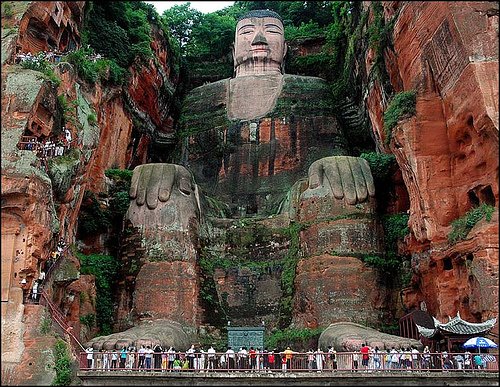
Dàfó (Grand Buddha), the world’s largest figure of Buddha, provides tacit testimony to the engineering skills of medieval Chinese civilization. It is carved from the Xiluo Peak of Mount Lingyun, facing the town of Leshan in the Sichuan Province of the People’s Republic of China. Work began on the 229-foot-high (71-meter) seated figure in a.d. 713 and took 90 years to complete.
Comparisons may give an idea of the ambitious scope of the project. Seated, the Grand Buddha is about 80 feet (25 meters) taller than the figure of the Statue of Liberty; were he standing, he would be over twice her height. His shoulders are 92 feet (28 meters) wide and his head 48 feet (14.7 meters) high; the Washington head on Mount Rushmore is 60 feet (18.3 meters). The Buddha’s big toe is 27 feet (8.3 meters) long, and 100 people can easily stand together on his instep. The practice of creating large statues of the Buddha probably began in India and spread throughout Asia. Standing and seated figures and others in the lotus position can be found in Bilingsi, China; Wat Thatorn, Thailand; and Kamakura, Japan. But the only ones that approached the size of the Leshan Buddha were in the Bamian valley of Afghanistan. Tragically, the two third-century-a.d. sandstone carvings, 182 feet (55 meters) and 125 feet (38 meters) high, respectively, were wantonly destroyed by the fanatical Taliban in March 2001.
The Leshan Buddha is in a serene region known as “Buddhist Paradise” and “Celestial World on Earth,” long associated with the religion in China. Nearby, the 10,000-foot (3,060-meter) Mount Emei, one of four sacred Buddhist mountains, rises steeply above the Dadu River. Once there were perhaps 100 pilgrimage sites—temples and monasteries—throughout its abundant forests. Many of them were originally Taoist foundations established during the Eastern Han dynasty under Emperor Ming (a.d. 58–75); others were added during the Ming and Qing dynasties (1368–1911). Not all have survived.
In the eighth century, Leshan, then known as Jiazhou, was a prosperous inland port and trading center. Silk and textiles from Chengdu, 105 miles (168 kilometers) to the northeast, and the agricultural bounty of the Chuanxi Plains were shipped down the Minjiang River to join the Qingyi Jiang and the Dadu, waterways that opened trade routes to much of China. The confluence of these fast-flowing streams created dangerous turbulence above a deep hollow, and boats often capsized. There is a tradition that a monk named Hai Tong, from the nearby Lingyun Monastery, initiated the carving of the Grand Buddha to quieten the waters. Ironically, because of the magnitude of the undertaking, involving a large workforce for almost a century, he did not live to see the figure completed. It may be difficult for the modern mind to grasp the singleness of purpose, on the part of Hai Tong and the builders alike, necessary to sustain such a project for so long.
Romantic tales are attached to the statue and the determined man who conceived it: he is said to have gouged out his eyes in some ruse to keep funding for the statue, and spent the remainder of his life in an abandoned cave tomb. As to the river, there is a tradition that it was calmed, perhaps because countless tons of discarded rock were thrown into the pool that caused the problem, perhaps by the watchful presence of Dàfó. Since 803 he has sat majestic, serene, and complete in his gigantic niche, flanked by standing warriors, also carved from the mountain. A path with nine turns winds down the rock face from the top of his head to the riverside platform before his feet; close to his right shoulder is the Great Buddha Temple (Da Fu Si). Until it was destroyed during a war toward the end of the Ming dynasty (1368–1644), a huge building covered the figure, although it seems not to have been to protect Dàfó from the weather. The ancient engineers devised a clever internal drainage scheme to prevent deterioration of the surface by diverting runoff—a system that until recently proved most effective. Now, rainwater seeping into the back of the statue is causing severe erosion. Other problems have arisen because of poor maintenance and repair practices in the past. A conservation plan has been developed, and in July 1999 the World Bank announced a U.S.$2 million loan for China to restore the Grand Buddha by improving internal drainage and reinforcing the base of the statue.
No comments:
Post a Comment